Adam Gold is a Ph.D. candidate in the Piehler Lab at the University of North Carolina Institute of Marine Sciences (UNC IMS). To learn more about his research, visit his website, follow him on Twitter (@acgold_04), or reach out to him via email.
We all know that the Mayfly Data Logger works great for monitoring inland streams, but what about coastal streams? This post describes our monitoring station design for coastal streams and how we are using Atlas Scientific sensors with the Mayfly.
Over the past few years, we have worked with collaborators to measure the impact of urban stormwater on the Rachel Carson Reserve and surrounding waters in Beaufort, North Carolina. Most of the field work for this project involved deploying Teledyne ISCOs for water level and velocity and YSI sondes for salinity and dissolved oxygen.
After hearing about the Mayfly and EnviroDIY from Scott Ensign (@ensign) during one of my dissertation committee meetings, my advisor (Dr. Michael Piehler) and I decided to supplement existing field work in one of our study streams with a DIY version of our equipment set-up.
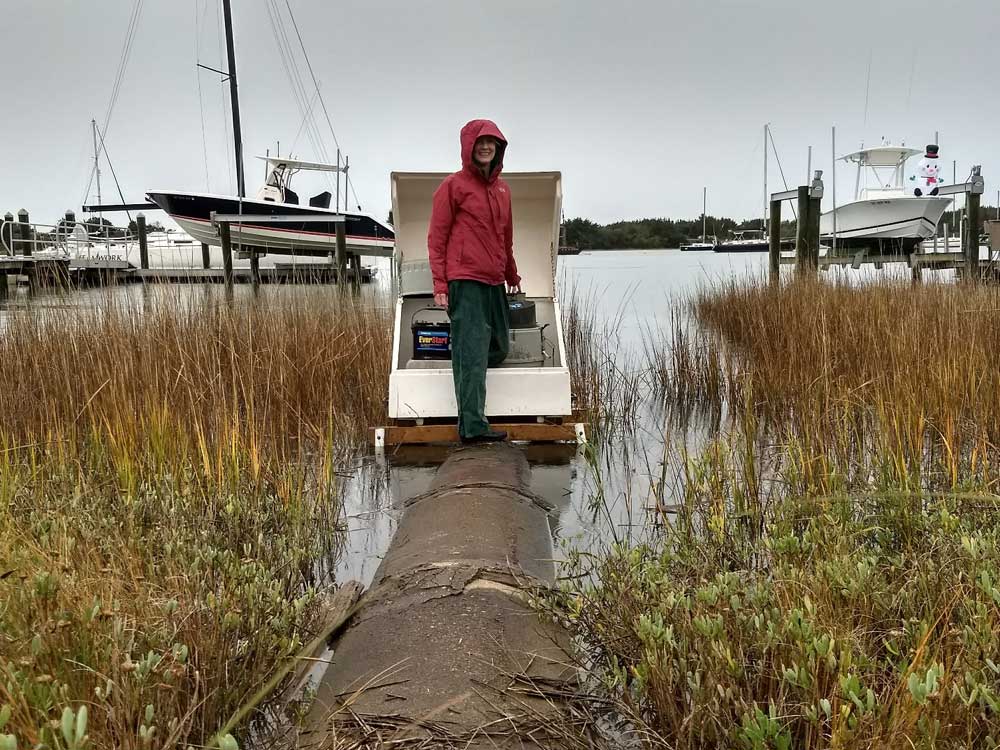
Suzanne Thompson, lab specialist for the Piehler Lab, checking for water samples from an ISCO during a rainy high tide on Taylor Creek near Beaufort, NC. This site receives full strength sea water through Beaufort Inlet and has a tide range of about 1 meter (for real-time and historic tide and water level data for Taylor Creek, visit NOAA’s station at Duke Marine Lab).
Design of the Monitoring Stations
Coastal streams have a few unique characteristics that influenced our monitoring station design, but here are the main two:
- Tides
- Bi-directional flow makes discharge estimates very difficult.
- Increased biofouling of sensors exposed to salt water.
- Wide and dynamic stream channels
- Very hard to survey channel cross-section accurately for discharge estimates.
- Would need to manage very long sensor cords to measure in main channels while keeping monitoring station dry.
To adapt to these characteristics, we had to forgo surveys for flow calculations in this system and aimed to use Atlas Scientific sensors that are cheaper and simpler to clean than the Hydros 21 conductivity/temperature/depth sensor that is often used with the Mayfly. We also decided to use a Maxbotix ultrasonic water level sensor so that we could position the monitoring station directly in the stream on a post or on a dock and not have to deal with long sensor cords from the banks (very similar to http://open-storm.org/node/).
Our first draft of the station featured a floating buoy embedded with the sensors so they don’t get buried by sediment during high tide. We plan to refine our floating sensor setup either by creating a heavier duty float with cable glands to hold the probes and/or a better floating arm setup (suggestions welcome!).
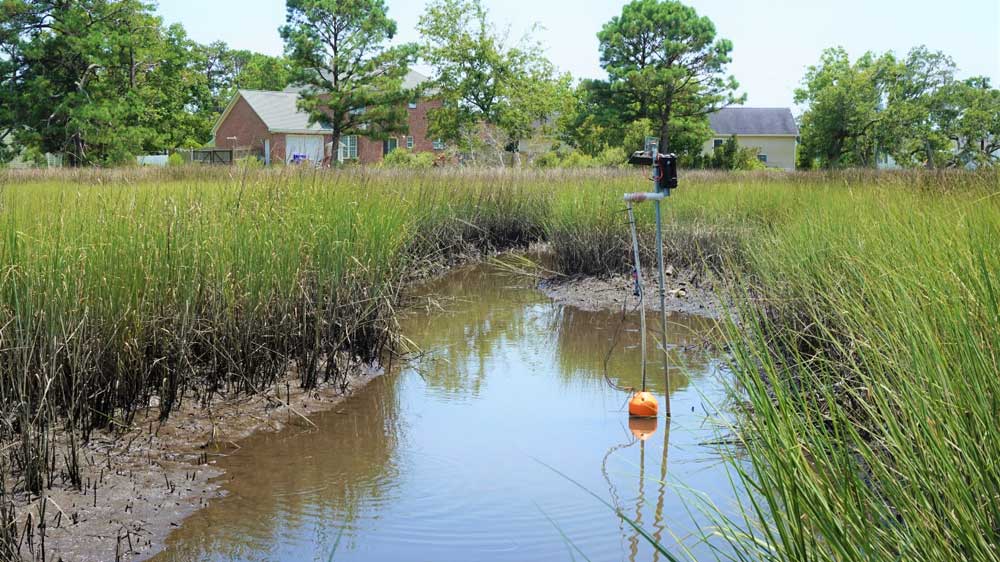
Sensor station in Town Creek in Beaufort, NC. This site receives salinity of >30 during high tide and has a tide range of about 1 meter.
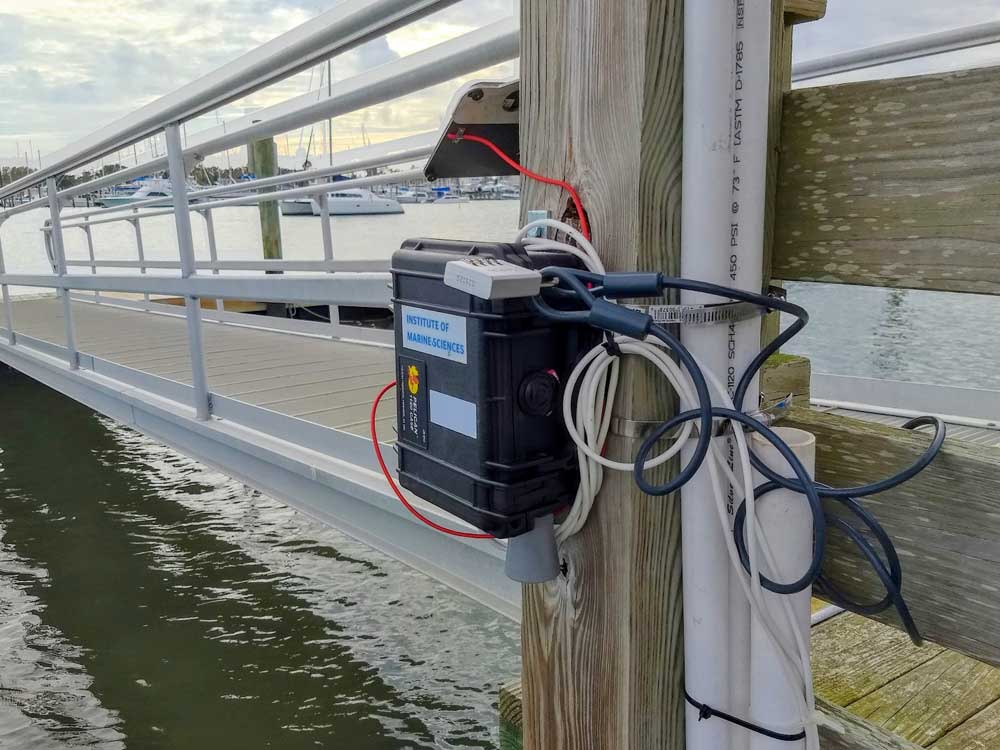
A dock-mounted sensor station near the mouth of Town Creek in Beaufort, NC. A Maxbotix ultrasonic water level sensor (gray cone) is attached at the bottom of the black waterproof box and faces down at the water below. Salinity at this site can be >30 and tide range is about 1 meter.
Using Atlas Scientific Sensors with the Mayfly
There were a few challenges to tackle before we could use the Atlas Scientific sensors with the Mayfly and ModularSensors code repository.
First, the carrier boards for sensor chips that were sold by Atlas Scientific at the time were expensive and required the use of a BNC connector. With a lot of help from Ryan Neve, the IT and Engineering expert at UNC IMS, I designed a carrier board that would hold the sensor chips and inline voltage isolators and allow us to get rid of the BNC connectors at the end of the probes. The carrier board was designed to have 5-pin and 3-pin headers that would allow sensor chips to plug in and be removed easily, terminal blocks instead of BNC connectors to plug in probe wires, and a single grove cable connection to the Mayfly. The carrier board uses I2C rather than the serial protocol, so Atlas Scientific sensors chips needed to be manually switched to I2C by following directions in the sensor manuals.
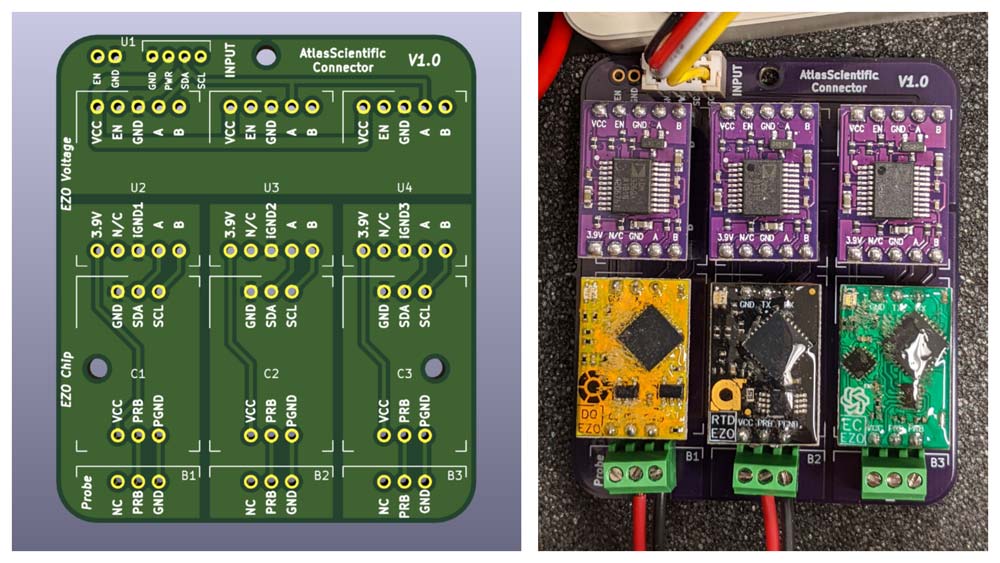
Rendering of the carrier board and the carrier board with sensor chips installed.
Second, we needed to make the Atlas probe wires longer for deploying in the field. The probes come with a 3-foot wire that ends with a BNC connector. After getting sub-par results using extension cords from Atlas Scientific and sealing the BNC probe-extension cord connection with CoaxSeal, we decided that the simplest thing to do was cut off the BNC connector and connect it to marine wire. Atlas Scientific has directions for cutting probe cables, so we followed their directions, spliced the probes to 9 feet of marine wire, and used heavy-duty marine heat shrink to waterproof the connection.
Finally, we needed to incorporate the Atlas Scientific sensors with the ModularSensors library. Using an Arduino sketch on the Atlas Scientific website and code for a simple sensor that used I2C in the ModularSensors library, I made some very rough code for the sensors. Thankfully, Sara Damiano (@srgdamiano) was able to clean up the code, expand it to work with most of the other available sensors, and add it to ModularSensors.
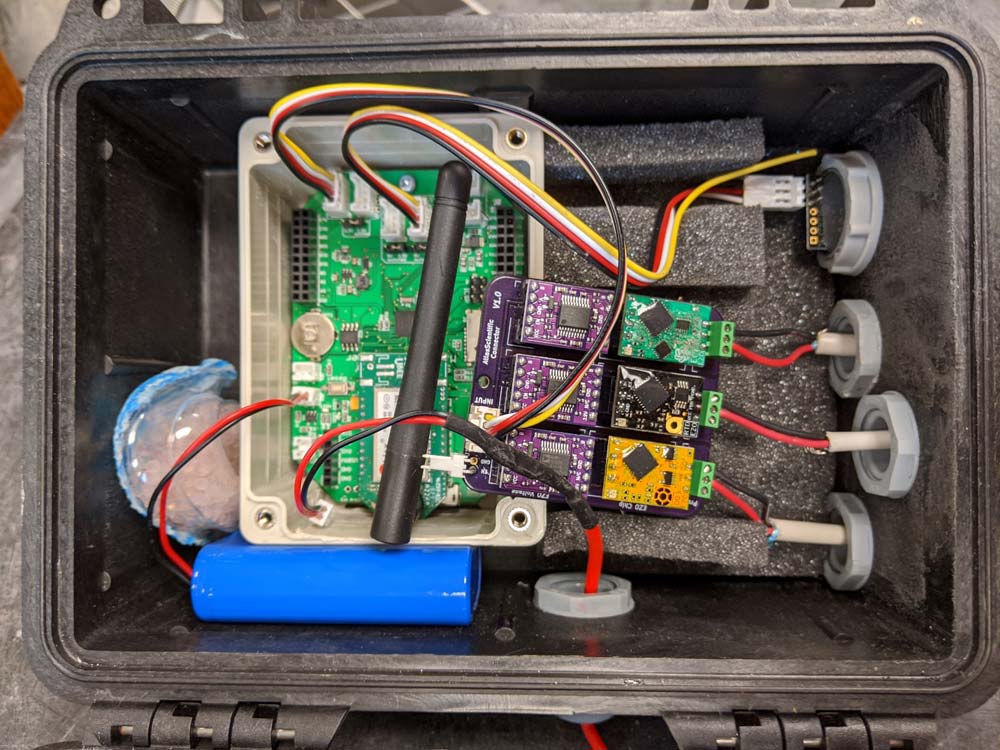
The inside of a monitoring station with a Mayfly Data Logger and the carrier board for Atlas Scientific sensors.
Tips for Using Atlas Scientific Sensors With the Mayfly
- We are getting good results with the Atlas Scientific sensors so far, but biofouling is a big issue that causes dissolved oxygen and electrical conductivity sensors to cut out after a few weeks if we aren’t able to go out and clean them. While Atlas Scientific sensors are relatively cheap and good if maintained well, optical sensors that include wipers may be better for areas where biofouling is an issue or when sensors cannot be cleaned often.
- There is a fair amount of labor involved with creating the carrier boards and splicing the probes to new wiring, but if Atlas Scientific switches to using SMA connectors instead of BNC, it would be easier to waterproof extension cables from Atlas Scientific with heat shrink and skip the splicing step. Customer service at Atlas Scientific says that this change might be coming soon, and they now sell a carrier board for individual sensor chips that uses an SMA connector.
- The conductivity probe may interfere with readings from other probes if it is taking a measurement right next to them in the water. The probes are electrically isolated on the carrier board, but this is something to keep in mind if you are doing your own wiring. I believe that all of the sensors take a reading at the same time in ModularSensors, so this problem could be fixed by implementing a measurement delay for the conductivity probe.
- Make sure that the I2C grove port is using “switched 3.3V” power so that the Mayfly can turn off the sensors between readings. If the power is on regular “3.3V”, the Mayfly will send a “sleep” command to the sensors between readings, but I am not sure how that will affect power consumption.
More Information
To learn more about how these stations were built, check out the documentation here. If you have any comments or tips regarding station design or sensors, please leave a comment below!

 Welcome to EnviroDIY, a community for do-it-yourself environmental science and monitoring. EnviroDIY is part of
Welcome to EnviroDIY, a community for do-it-yourself environmental science and monitoring. EnviroDIY is part of
Adam did you see my blog on “low cost EC sensor” ? I was using the Atlas sci probes but switched to the Sensorex probes which are cheaper. A more expensive version is available with an intergrel 10K RTD for temperature measurement. It comes with a 3m cable and pigtails – no BNC!
Jim, I read your blog post and plan to test out the Sensorex probes with future monitoring stations. The wiring and automatic temperature compensation would definitely be a time saver! Thanks for the comment!
Jim, Adam: I would be interested to hear if you have considering using the non-contact toroidal conductivity sensors from Sensorex for water monitoring since you have concerns about biofouling and you are in a saltwater environment. The inital cost of the toroidal sensor is high in comparison to the contact type sensors , but over the life of the sensor the initial cost I believe would be offset by the quality of the data and the large reduction in labor for sensor maintenance. https://sensorex.com/product/tcs3020-toroidal-inductive-conductivity-sensor/
I have several years using these sensors in industrial applications that required the biofouling resistance. I also helped deploy torodial sensors aboard a sailing vessel that was monitoring both freshwater and sea water. I am interested to hear your feedback. What is your expected range of conductivity measurements.